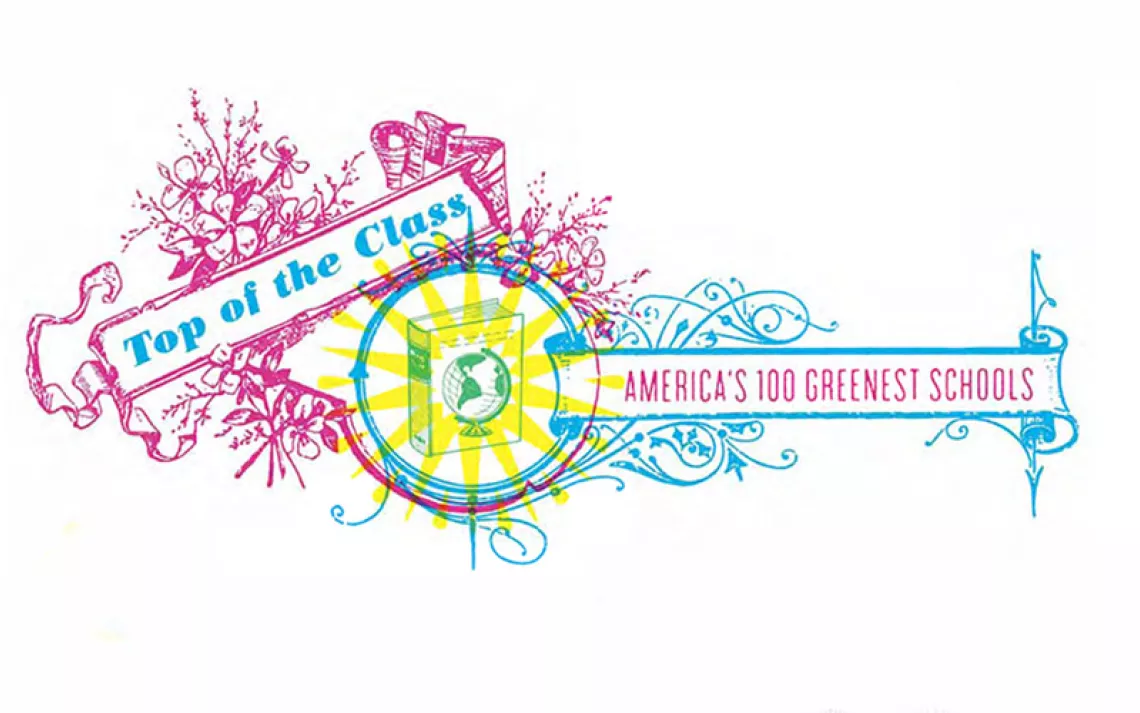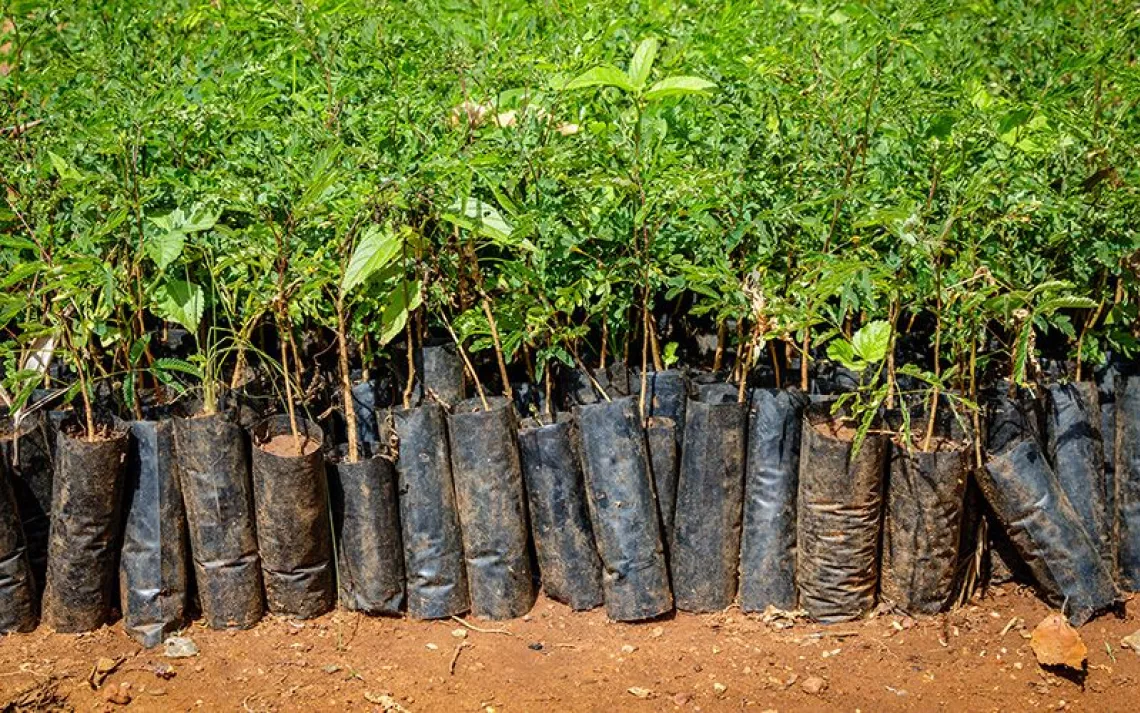The Top 20 Coolest Schools 2017
These schools are ahead of the curve when it comes to sustainability

The Complete Ranking: All 227 Schools | Scoring Key | Methodology | FAQ | More Cool Schools
20; Oregon State University
Score: 669.14 | Corvallis, Oregon

Oregon State University students Annie and Nazario, at work in one of OSU's many student- and volunteer-managed gardens. | Photo courtesy of Oregon State University
Not only has Oregon State's solar partnership Solar by Degrees program resulted in the installation of 12 acres of photovoltaic arrays since 2013, but its research into the effects of solar panels on soil and crop production is showing that both benefit. And that putting crops underneath photovoltaic panels can help produce more electricity. In 2016, OSU dining services kept 400,000 disposable containers out of landfills by introducing reusable (and returnable) take-out containers. Earlier this year, trustees approved an amendment to divest from current fossil fuel holdings and restrict future investments. The Beavers made a 58-spot leap in 2017 and seem well on their way to meeting their carbon neutrality goal by 2025.
19: Oberlin College
Score: 670.69 | Oberlin, Ohio
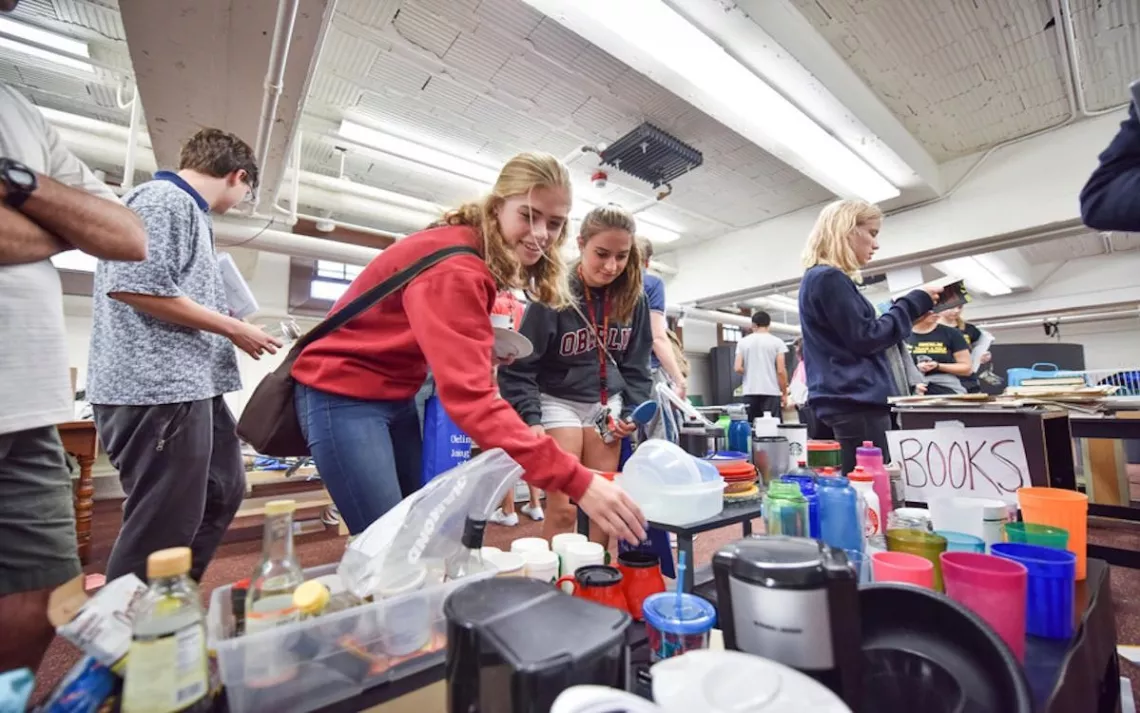
First-year students shop for move-in items at Oberlin's Fresh Swap, a free store boasting items new students need most (trash cans, school supplies) donated from students who moved out the previous year. The event is hosted by the Resource Conservation Team (RCT), a student group devoted to resource reduction initiatives. | Photo courtesy of Yevhen Gulenko, 2015
In the decade since Oberlin committed to carbon neutrality by 2025, the small liberal arts school has halved its emissions, thanks largely to a 2.27-megawatt solar array and its decision to transition the campus heating plant from coal to natural gas. Last year, the school partnered with the city of Oberlin to improve sustainability and efficiency in the community at large, and thus better fortify against a changing climate and its attendant public health and safety concerns. This mindset is also at play in the annual Oberlin Ecolympics—a three-week competition among dorms and co-ops to reduce electricity and water use. This year, Oberlin opened up the games to faculty and staff.
18: George Washington University
Score: 670.82 | Washington, D.C.
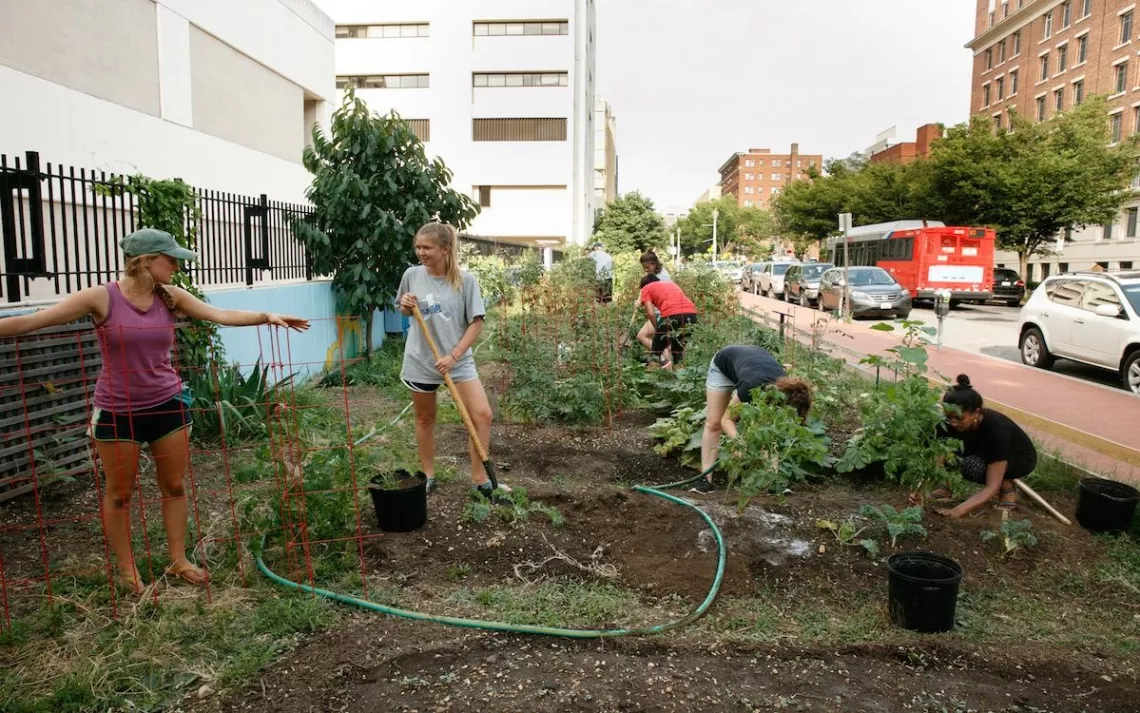
George Washington University's GroW Garden is a collaborative project bringing together students, faculty, staff, and the community to engage in growing food in an urban environment. A majority of its produce is donated to Miriam's Kitchen, a local soup kitchen. | Photo courtesy of George Washington University
After getting off at the Foggy Botton-GWU Metro Stop in our nation's capital, policymakers pass through a campus that models rain gardens, vegetative roofs, apiaries, and, thanks to a recent student design competition ("Charged Up"), solar personal-device charging stations. As of this year, 50 percent of GW's electricity comes from a 53.5-megawatt solar farm, due to an innovative and cost-cutting partnership with the GW Hospital and American University. GW recently introduced a program to bring native plants, pollinators, and predators like ladybeetles back into its urban ecosystem. Popular new courses include The Sustainable City, The Sustainable Plate, and Climate Change Policy. This fall, GW is unveiling its Food Policy Training Institute.
17: University of the Pacific
Score: 676.10 | Stockton, California
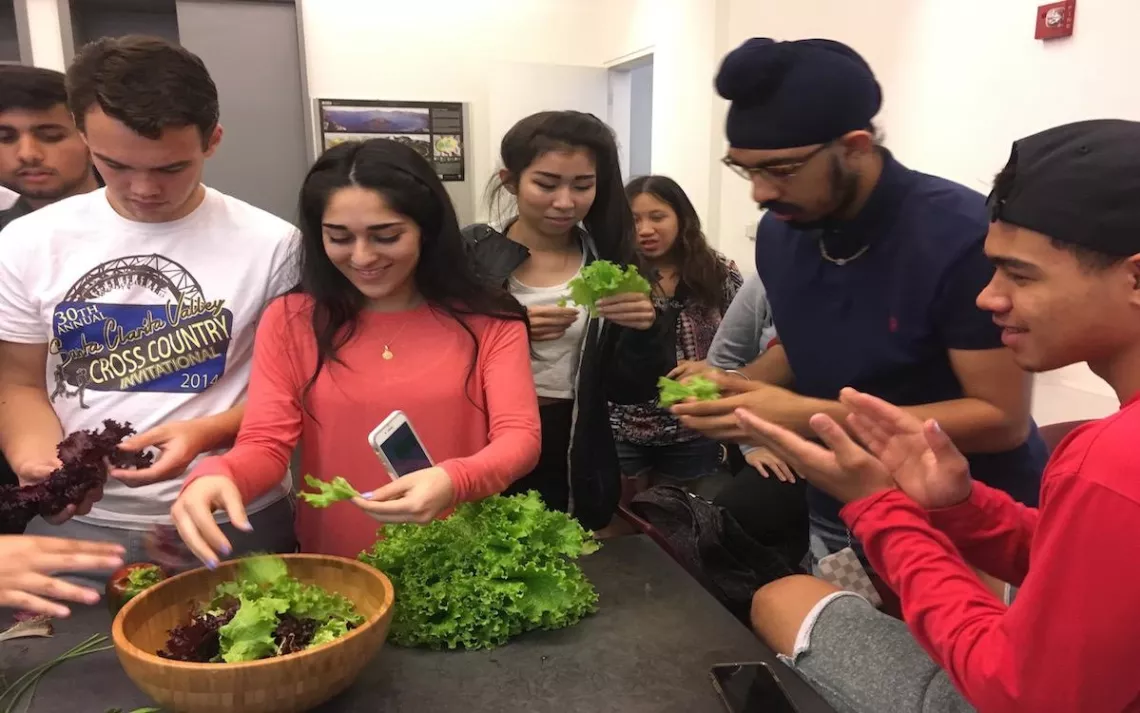
Students studying Intro to Environmental Studies at University of the Pacific devoted a unit to food-production issues, during which they planted lettuce seedlings and harvested the fruits of their labors to make salad. | Photo courtesy of University of the Pacific
University of the Pacific undergrads can minor in sustainability, and grad students can pursue an MA in food studies—the first program of its kind on the West Coast—or go to law school to focus on water law. Three organic gardens provide a teaching laboratory while also helping to feed residents of California's Central Valley. The Pacific Green Team—composed of student volunteers—implements campus-wide composting and educates fellow students about landfill waste diversion during move-in and move-out. The biggest annual event, a Green Fashion Show, attracts members of the community for a colorful showcase featuring get-ups created from plant matter, upcycled thrift store purchases, garbage materials, and organic textiles.
16: Loyola University Chicago
Score: 676.23 | Chicago, Illinois
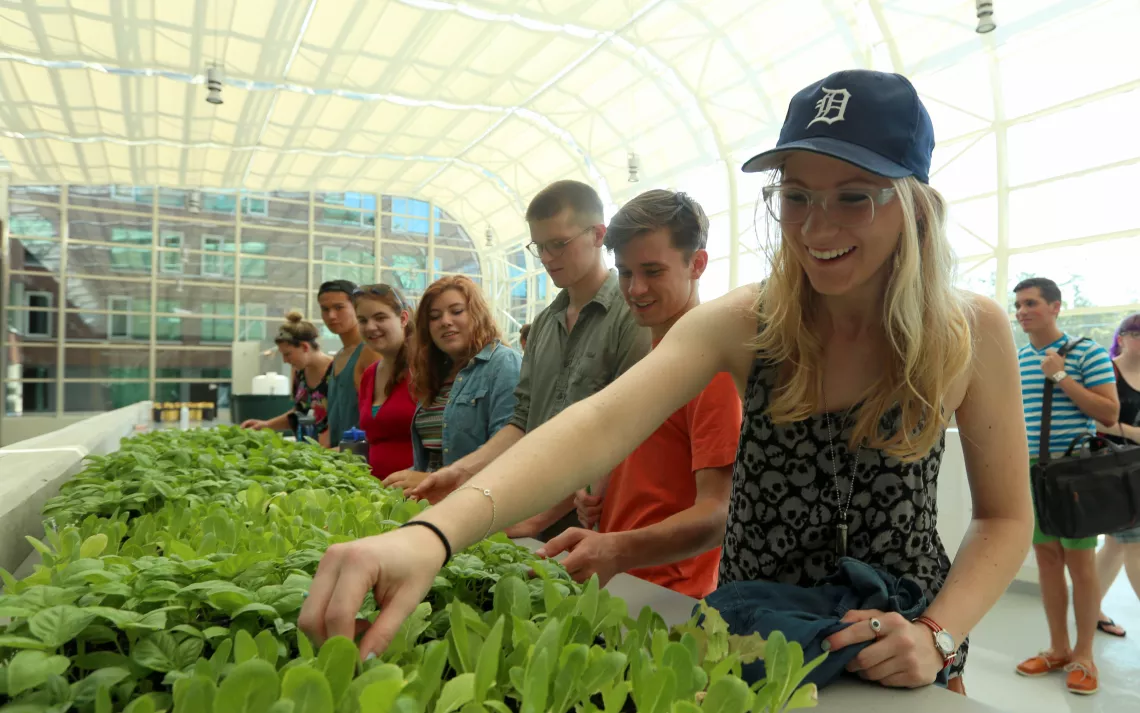
Loyola's Institute of Environmental Sustainability (LEED Gold) combines a residence hall and research labs, including an award-winning sustainable food and urban agriculture program. | Courtesy of Loyola University Chicago
This year, Loyola partnered with the Archdiocese of Chicago to facilitate student-administered energy audits of the city's Catholic churches, cemeteries, and hospitals. The community-minded Jesuit university also operates a Compost Collection Network, through which students train local businesses to reduce their food waste. On campus, a student-run green cafe, Engrained, features local farms' bounty and, to encourage large-scale conscious consumption, a catering operation. Incoming students attend "Loyola 101 Sustainability" trainings, and staffers who purchase commute-shortening homes near campus receive subsidies. (The school also subsidizes all student and staff membership in Divvy, Chicago's bike-share program.) Loyola recently rolled out an Energy Efficiency Plan—including guidelines for temperature, lighting, thermostats, and devices—to support its 2015 Climate Action Plan.
15: Colgate University
Score: 683.27 | Hamilton, New York

The 2017 kickoff of Colgate's Green Summit—13 days of sustainability-themed festivities (screenings, zero-waste picnics, a Spring Cleaning Clothing Swap, and more) leading up to Earth Day.| Photo courtesy of Colgate University
At this small liberal arts college, the belief that environmental well-being is crucial to wellness is pervasive. Courses like Foundations of Sustainability—an interactive forum to discuss personal choices that affect the environment—count toward physical education requirements; environmental studies majors must take environmental justice courses; a beekeeping club harvests honey from the campus garden's apiary; and a sustainability dining manager works with farmers to get local fare on students' plates. Every new building or major renovation must be LEED silver-certified, at minimum. The Raiders have reduced net emissions by 48 percent since 2009 and are well on track to carbon neutrality by their goal, 2019. It all adds up to an impressive 18-point leap.
14: Chatham University
Score: 684.66 | Pittsburgh, Pennsylvania
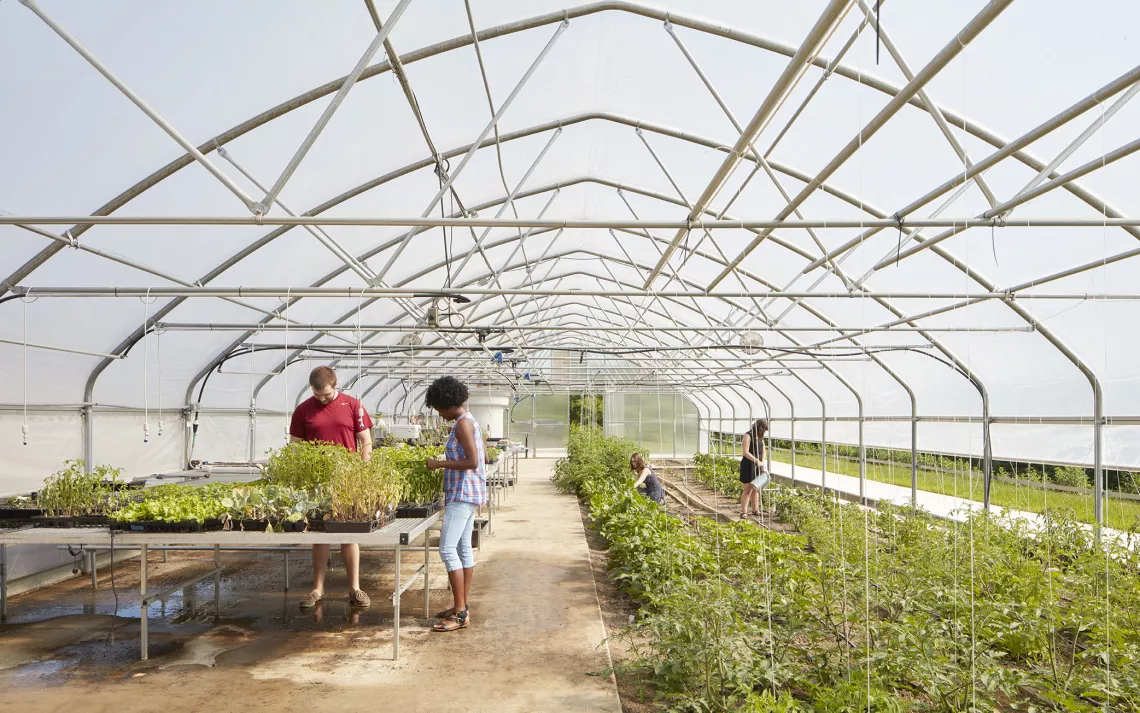
On the left, students work with seedlings that are ready for transplanting. On the right, a student waters newly planted seedlings, while another harvests tomatoes from a previous planting. The solar-thermal-heated Hoop House grows food year-round, supplying the Eden Hall dining hall. | Photo courtesy of Bruce Damonte
Chatham has taken up residence at a new campus, Eden Hall, a 388-acre historic site that underwent a retrofit to become energy-positive. There, students grow their own food and attend LED-illuminated classrooms to study agroecology, aquaculture, and food studies. Despite the added square footage, Chatham has halved its emissions since 2006. Students and staff who make small concessions purchases using credit cards can meet the minimum $4 charge not by buying more junk food, but by contributing to a Student Green Fund, used to fund student projects. This year, a group of physical therapy grad students secured university funds to decorate their building with plants and to distribute monthly Did You Know? fact sheets containing green lifestyle tips.
13: Harvard University
Score: 687.21 | Cambridge, Massachusetts
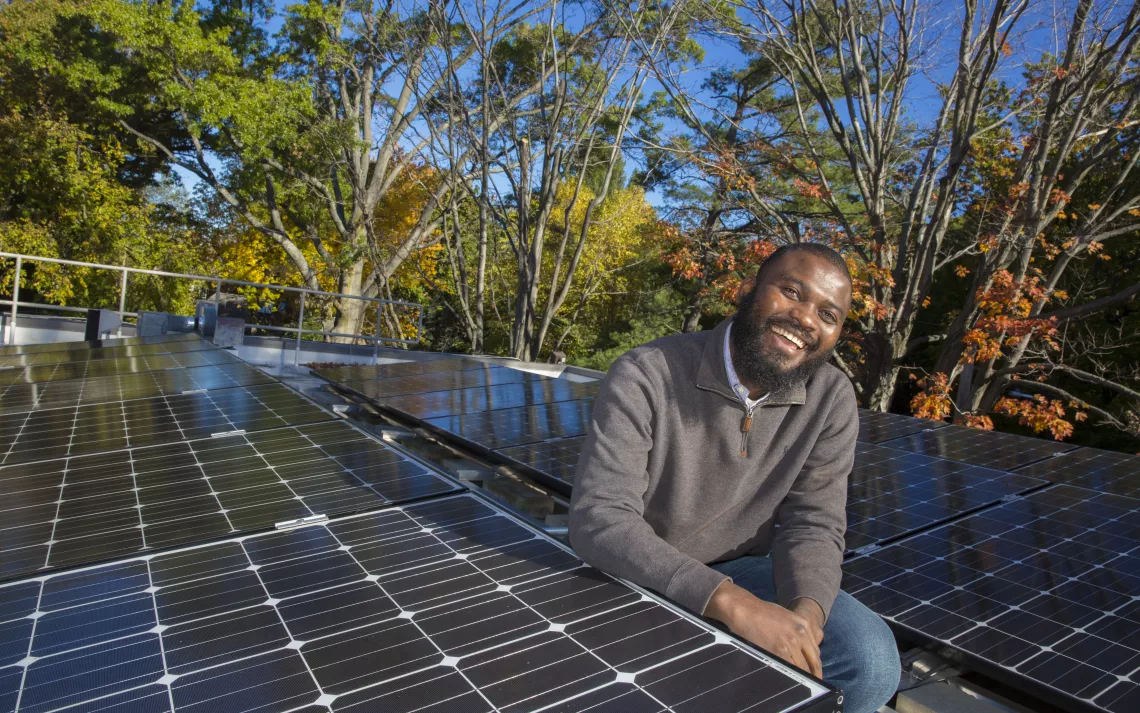
18 on-site solar arrays decorate the roofs and grounds of Harvard's campus, producing more than 1.5 megawatts of power. Solar thermal, biomass, and geothermal installations also play an important role in decarbonizing the university's energy supply. | Photo courtesy of Kris Snibbe, Harvard staff photographer
The oldest U.S. institution of higher learning this year met its goal of reducing emissions by 30 percent from 2006 to 2016 after doubling down on energy efficiency in all 600+ buildings, installing geothermal wells under Radcliffe Yard, purchasing local renewable energy, and installing rooftop solar. Updated green building standards led to last year's launch of the Harvard Healthier Building Materials Academy, through which researchers seek out ways to reduce the use of harmful chemicals in building materials and products. What's more, Harvard's Global Health Institute has started researching how climate change will affect human health, and its Center for Green Buildings and Cities retrofitted its headquarters, a pre-1940s Cambridge house, creating HouseZero, a prototype modeling ultra-efficiency.
12: Middlebury College
Score: 688.30 | Middlebury, Vermont
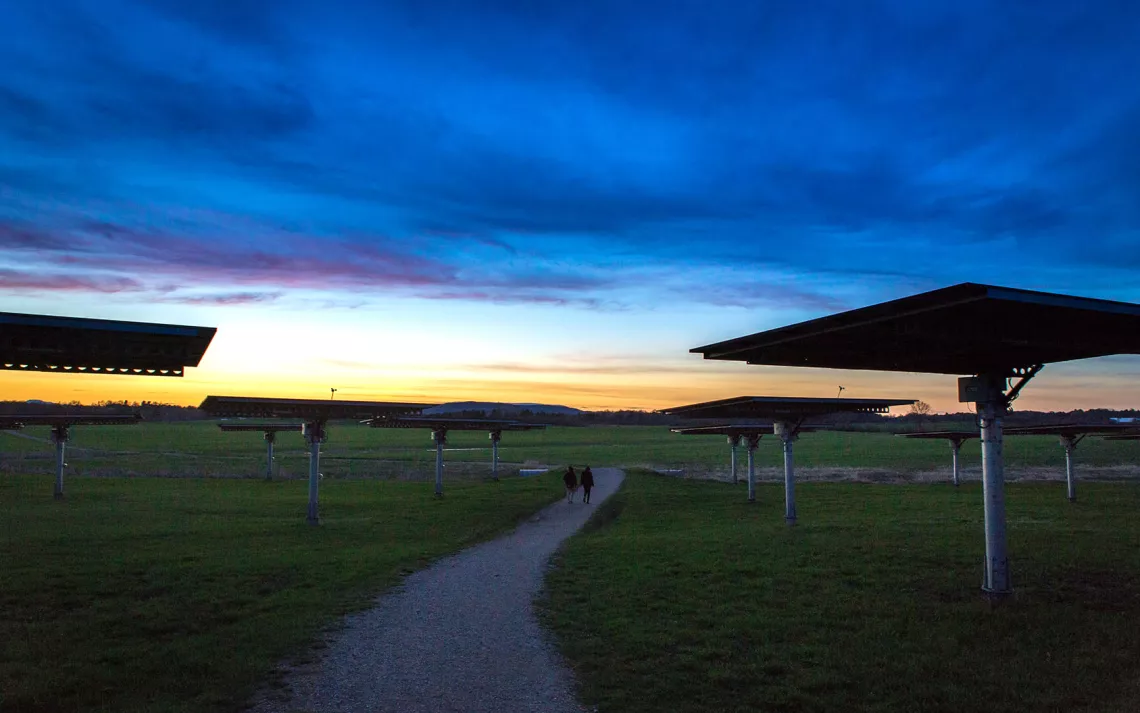
At the urging of students, Middlebury built a 1.5-acre solar farm that produces about 243,000 kilowatt-hours each year. Photovoltaic monitoring sensors collect and store data for student and faculty research. | Photo courtesy of Chris Spencer
Last December, the home of America's first environmental studies program reached carbon neutrality—thanks to student-driven measures including a biomass facility that burns locally sourced wood chips to heat and cool the campus, three solar projects totaling 1.1 megawatts, and the conservation of 2,100 acres of adjoining forestland. Middlebury recently joined with several study-abroad partners to create Global Partnerships for Sustainability, which has students jetting off to engage Chinese children and their families in wetland and biodiversity conservation and helping to develop plans for Chilean national parks.
11: Colorado State University
Score: 696.71 | Fort Collins, Colorado
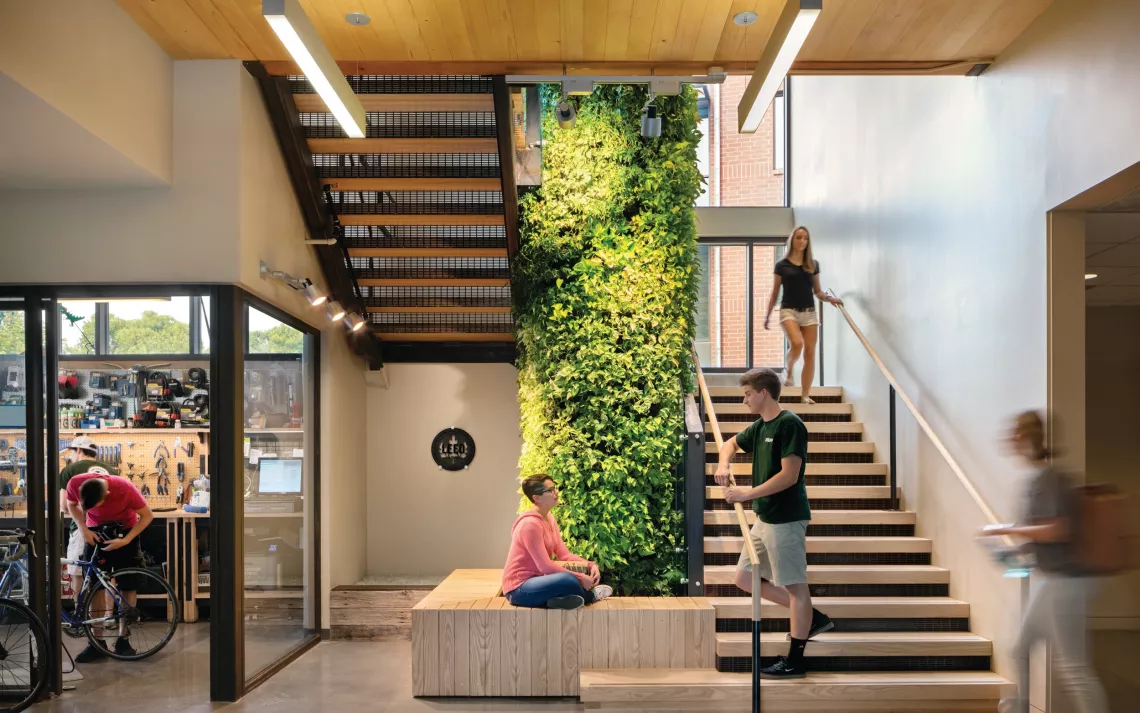
Students congregate around the green wall in the Pavilion, one of Colorado State University's LEED Platinum buildings. The Pavilion is a 24/7 student gathering space featuring a bike repair room, office space for EcoLeaders (sustainability peer educators), a seminar room, and social and study spaces that include hammocks, a living slope, and garage doors that open to outdoor seating areas. | Photo courtesy of Colorado State University
For the 30,000+ Rams, campus life starts with a zero-waste picnic. No matter which of the eight CSU colleges that students are enrolled in, they can declare sustainability-related majors and minors, sup in cafeterias that divert 93 percent of waste through composting and single-stream recycling, and live and learn in 26-and-counting LEED-certified buildings. The mountain campus is so bike-friendly it received "platinum" status from the League of American Bicyclists, and it also boasts 25 electric vehicle charging stations. With 13 solar arrays, ground-source heat pumps replacing traditional steam and chillers in the sports complex, and a 24-percent reduction in water use since 2007, CSU seems well poised to achieve its goal of climate neutrality by 2050.
10: University of San Diego
Score: 702.05 | San Diego, California
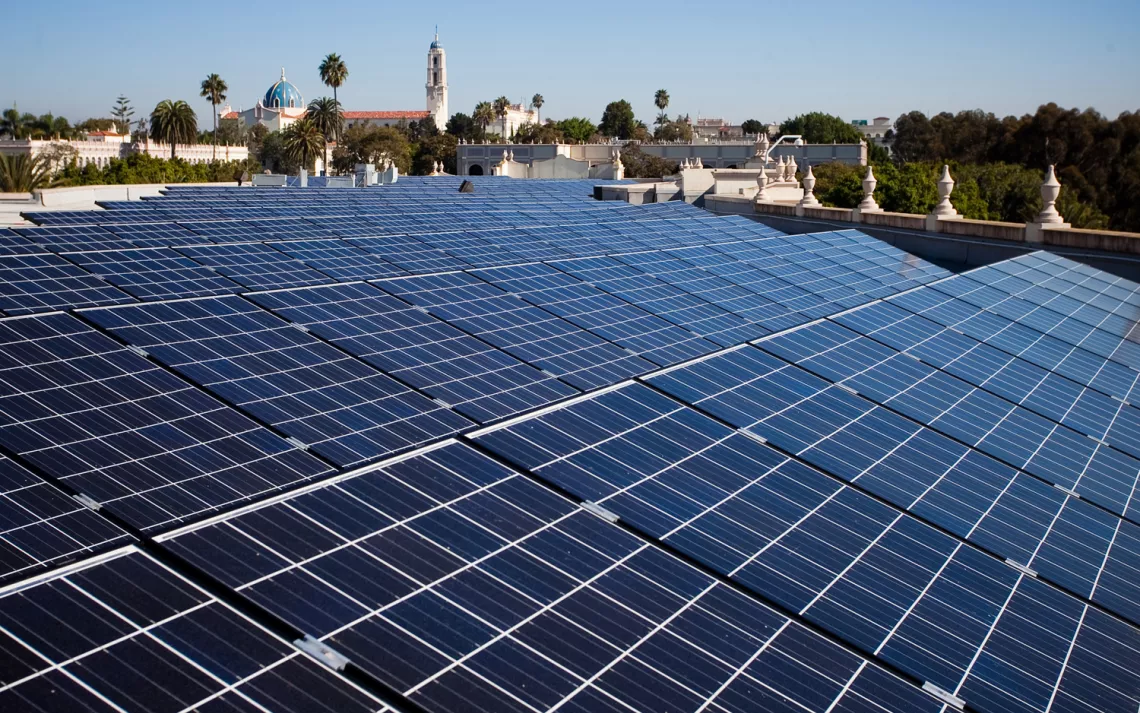
Since installing a 1.2-megawatt solar system across 12 buildings on campus in 2010, the University of San Diego has saved more than $200,000. | Photo courtesy of the University of San Diego
After Pope Francis issued his landmark 2015 encyclical, Laudato Si', calling on Catholics to confront climate change, USD made "care for our common home" an explicit part of its mission. The Catholic university operates one of San Diego's only electronic-waste recycling centers, coordinates local governmental climate action through the Climate Collaborative, and runs a nonprofit energy-policy initiative. Cementing USD's break into the top 10, the university has saved more than 10 million kilowatt-hours and 30 million gallons of water annually since 2010, thanks largely to a 1.23-megawatt solar array, a lighting retrofit, and extensive use of fuel-cell power.
9: Colby College
Score: 711.69 | Waterville, Maine
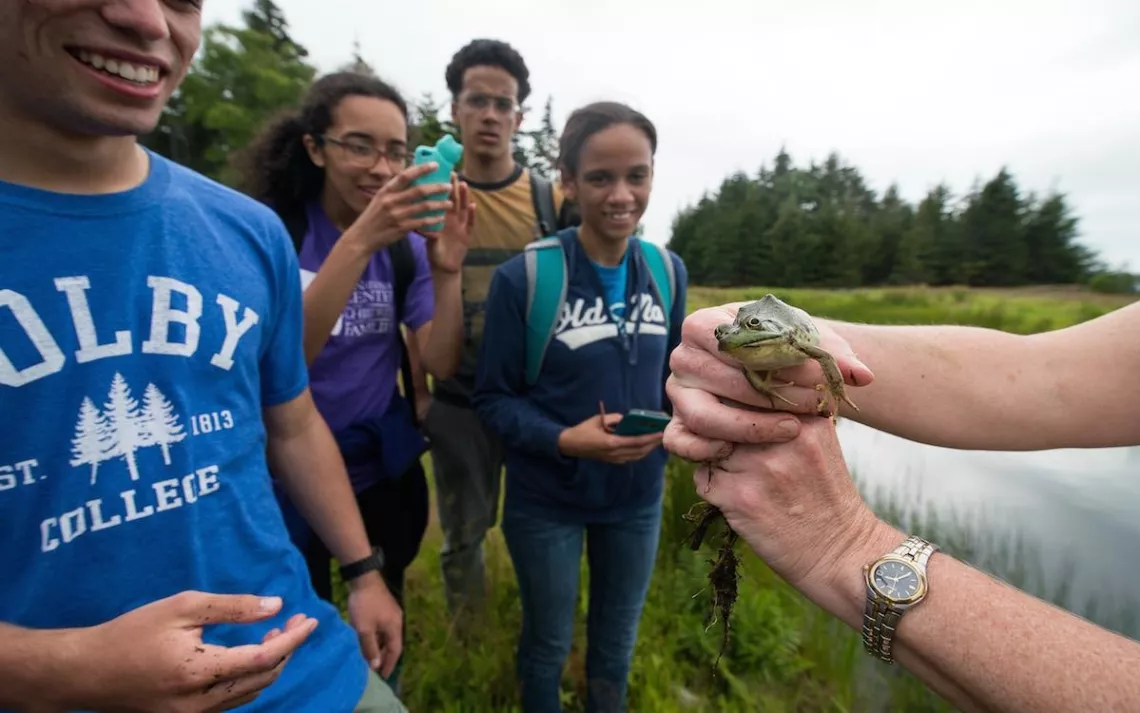
Colby College students get a close look at a frog that is native to Allen Island, an island off the coast of Maine and a learning center for the college. Off-camera and holding the frog is amphibian expert and associate professor of biology Catherine Bevier. | Photo courtesy of Colby College
In the 1970s, Colby was at the vanguard of introducing academic environmental programs. This past year, it implemented a focus in environmental humanities across all departments. The idea is to bring artistic, cultural, historical, and literary perspectives to classes focused on the built environment and the evolving human-nature relationship. With 15 (and counting) LEED-certified campus spaces and a dining hall that sources the fruits of the Colby Organic Farmers and Gardeners Association, the college declared carbon neutrality in 2013—two years ahead of its goal. A new, 1.9-megawatt solar installation will soon generate 16 percent of Colby's electricity.
8: University of California, Irvine
Score: 714.66 | Irvine, California
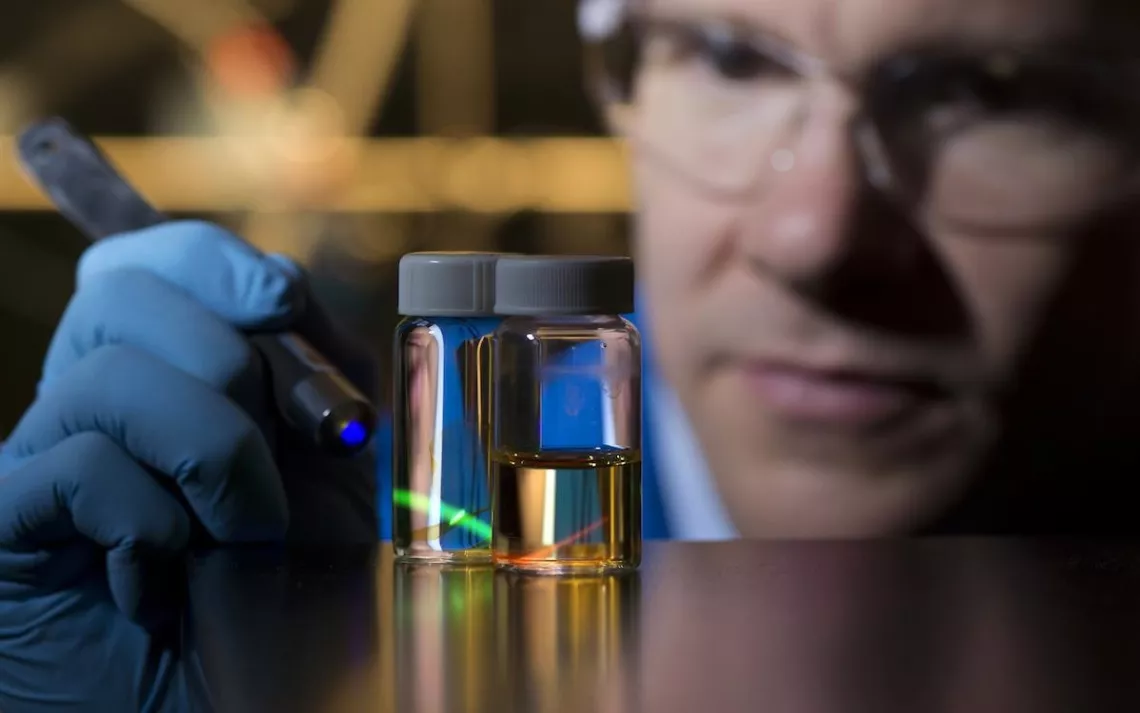
UCI chemist Shane Ardo shines a purple laser through glass vials containing dye molecules embedded in polymer plastic membranes that his lab designed—and which could eventually be used in personal devices that easily, cheaply, and sustainably desalinate seawater. "Imagine if you could dip a plastic bottle in the ocean and have that container take the salt out of the water in front of your eyes," says Ardo, an expert in solar energy, electrochemistry, physics, and materials science. "My lab is on track to perfecting technologies to sustainably and inexpensively desalinate seawater for both personal consumption and agriculture." | Photo courtesy of Steve Zylius/UCI
UC Irvine has long used its campus to experiment with cutting-edge energy efficiency technology. After rendering its labs "smart" via sensors that measure close to 500,000 data points every five seconds, UCI reduced the Anteaters' energy consumption by 50 percent. Last year, engineers implemented the first power-to-gas hydrogen pipeline injection project in the United States. Surplus energy from the school's 17 solar installations converts water to hydrogen and blends it with gas; the mixed fuel can be stored for later use. The first application in the works? Powering a zero-emission hydrogen-fuel-cell bus fleet—a college campus first—set to debut this fall.
7: Arizona State University
Score: 715.28 | Tempe, Arizona
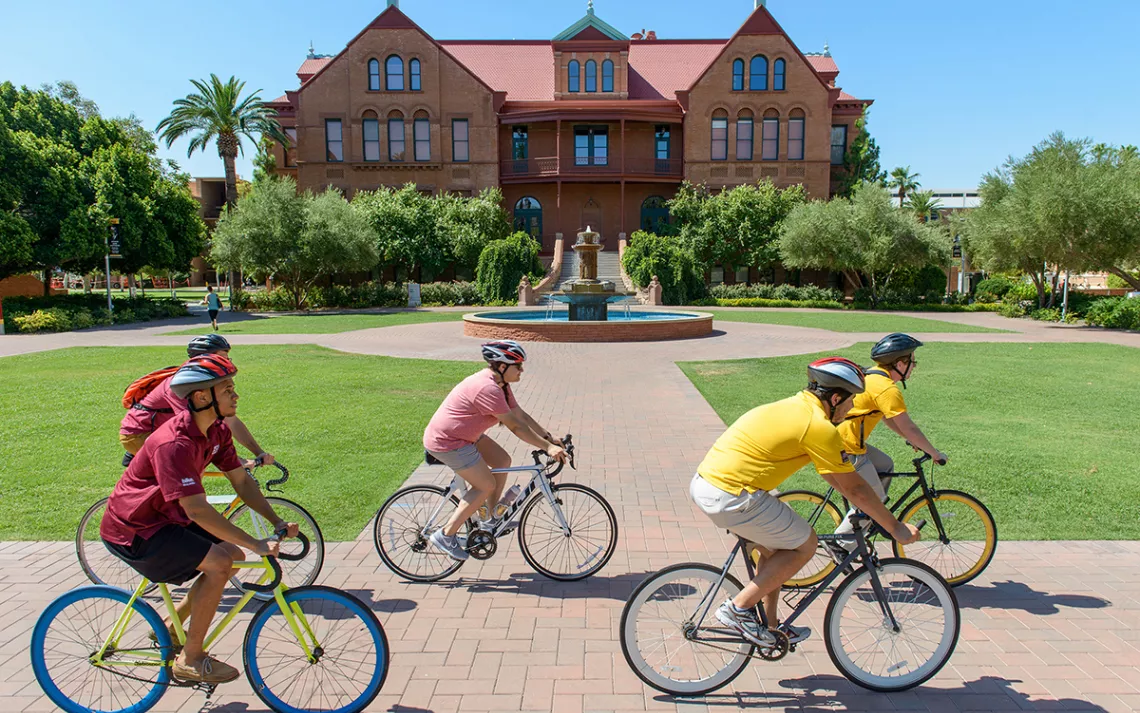
Arizona's new Red Rock Solar Plant boasts 182,880 solar panels, which will generate 40 megawatts of power to be split between ASU and PayPal. The facility, located on 400 acres adjacent to the Saguaro Power Plant, was dedicated on Wednesday, January 11, 2017. | Photo by Charlie Leight/ASU Now
With more than 98,000 students, Arizona State is mindful of its significant footprint. In January, the Sun Devils collaborated with the local utility to launch a huge desert solar array, driving the development of more than 50 megawatts of solar for Arizona while meeting 30 percent of their own electricity needs. A decade ago, ASU made waves with the launch of its School of Sustainability, through which students either earn BAs (the Urban Dynamics program is popular) or study ecosystems and sustainable economics for a BS. This year, freshmen will complete the Seeds of Sustainability program, which features serial, Schoolhouse Rock!-like videos with titles such as "What Is Climate Change?" and "Biomimicry Biophilia."
6: Loyola Marymount University
Score: 720.05 | Los Angeles, California
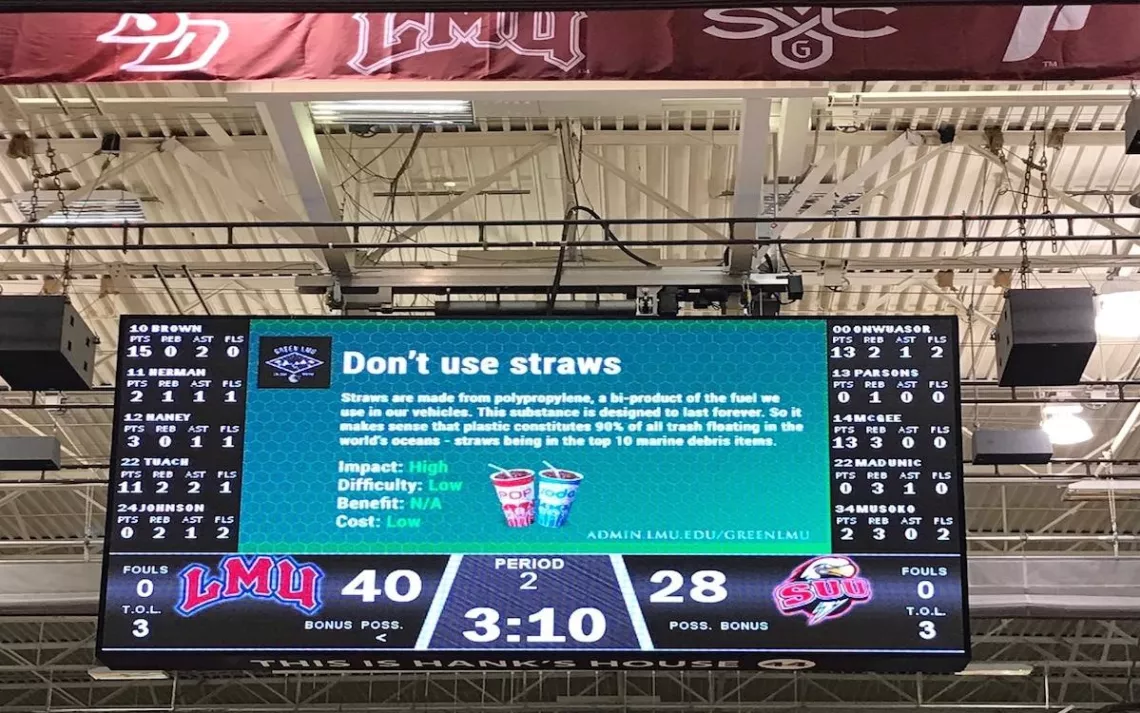
A green LMU basketball game. | Photo courtesy of Loyola Marymount University
With almost 90,000 square feet of solar-powered rooftops, reclaimed-water irrigation systems, and a first-place medal from RecycleMania—an inter-university waste-management competition—LMU gained 137 points' worth of green bona fides, breaking into the top 10. At a university-led recycling plant, students sort materials and dehydrate liquid waste to create soil additives; in fact, the Lions are on track to divert all food waste by fall 2018. At LMU, even baseball and basketball games are venues for environmental education, with sustainability-focused announcements and no paper programs. Students are converting a donated shipping container into a bike-sharing and repair center.
5: Lewis & Clark College
Score: 724.53 | Portland, Oregon
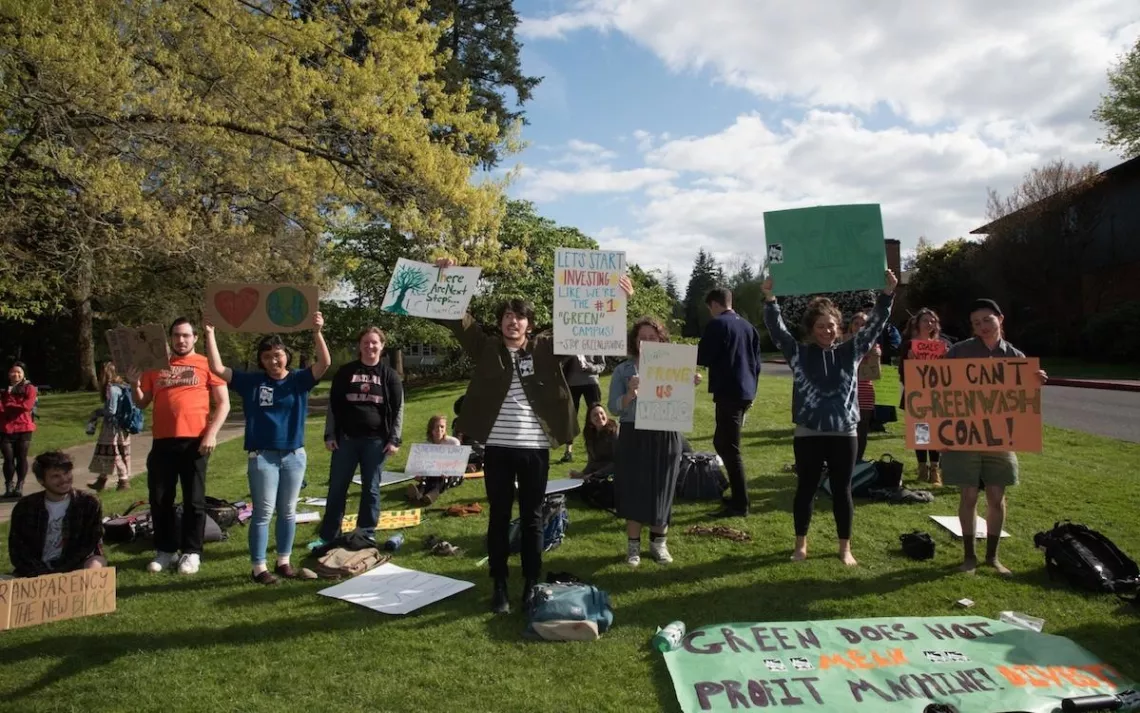
Lewis & Clark students' movement to get their school to divest from fossil fuel interests has paid off. | Photo courtesy of Lewis & Clark College
It's hardly surprising that a school that was willing to undertake a recent "alternative technology review process" to legalize its composting toilets and that labored to get its river-run campus designated as Salmon-Safe also boasts a student body that voluntarily chips in for enough offsets to cover its greenhouse gas footprint. The Pioneers improved their score by 52 points this year, thanks in part to a vote to divest from fossil fuels, a CSA partnership with local farmers, and the creation of Campus Market—an online sharing platform designed to keep students' clothing, furniture, and books out of landfills.
4: State University of New York College of Environmental Science and Forestry
Score: 724.85 | Syracuse, New York
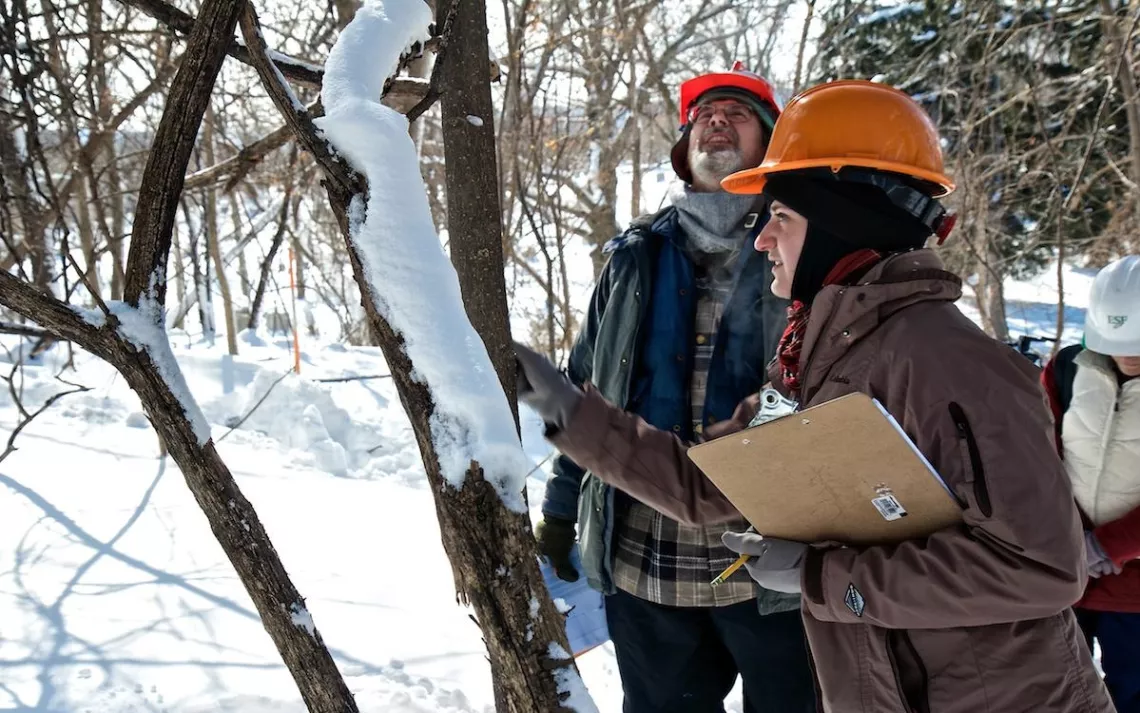
Fieldwork is part of an ESF education. Here, a student and faculty member work side by side in a snowy patch of forest. | Courtesy of the State University of New York College of Environmental Science and Forestry
It's been a big year for the greenest campus within the country's largest public university system. SUNY-ESF established a Green Revolving Fund—through which energy savings and investment returns are channeled to fund future sustainability initiatives—and equipped its buildings with controls that allow for more fine-tuned management of energy and water use. And after the school swore off pesticides and committed to a native, largely edible landscape (students can pick apples and strawberries en route to class), the Center for Food Safety certified SUNY-ESF as "pollinator-friendly."
3: Sterling College
Score: 739.98 | Craftsbury Common, Vermont

Students expand their senses of self and community by learning about the natural communities among the high peaks of the Sierra Nevada, through the Natural History of the Sierra Nevada Global Field Study. | Photo courtesy of Sterling College
At Sterling, one of seven federally recognized work colleges, where students labor in exchange for tuition, 140-some undergrads tend to livestock and harvest produce on their campus farm and manage forestlands and trails. Most forge their own majors out of the fields of ecology, outdoor education, environmental humanities, and sustainable food systems. For the second year in a row, Sterling placed first in the Real Food Challenge, a nationwide campaign to shift university food budgets toward organic sources. The college divested from fossil fuels in 2013 and this year finished eight solar installations that generate 80 percent of its electricity. These efforts resulted in an impressive 21-spot jump.
2: Green Mountain College
Score: 745.80 | Poultney, Vermont

Current sophomores Merone Eckert (right) and Bella Powers harvest potatoes at Green Mountain College's Cerridwen Farm. | Photo courtesy of Green Mountain College
Visitors to Green Mountain College might spy solar photovoltaic arrays on garages, electric tractors, and tiny houses—all of them created by the school's ecological design students. This year, the school jumped eight spots, due in part to having introduced new programs in resilient and sustainable communities and local food systems. All GMC students take environmental classes (think Animal Ethics and Dimensions of Nature), and everyone contributes to a campus greening fund, chosen through a campus vote. It's how GMC ended up with a biomass facility, a bike-sharing program, and a bat habitat.
1: College of the Atlantic
Score: 779.58 | Bar Harbor, Maine

College of the Atlantic students hike along a rocky trail in the vast northern Maine woods during one of the school's Outdoor Orientation Program (OOPs) trips. Each fall, around 75 percent of COA's incoming class joins a weeklong OOPs adventure, where they experience the Maine wilderness, learn about COA culture, and make some of the closest friends they'll have over the next four years. | Photo courtesy of Aubrielle Hvollboll, COA class of 2020
Clinching number one for the second year running is College of the Atlantic, which has divested from fossil fuel companies and is working toward 100 percent renewable energy, and where all 350 students study human ecology. In the last year, the school committed to diverting 90 percent of campus waste by 2025. Since the 2016 rankings, it also grew its Hatchery, an incubator for sustainability-oriented student enterprises such as Reproduce, a venture to market cosmetically imperfect produce. Other students are engaged in an initiative to provide local farms and businesses with solar-power-financing consultations. Classes meet at adjacent Acadia National Park, on two organic farms, and, 25 nautical miles south of campus, at an island research station dedicated to the study of marine mammals.
 The Magazine of The Sierra Club
The Magazine of The Sierra Club
